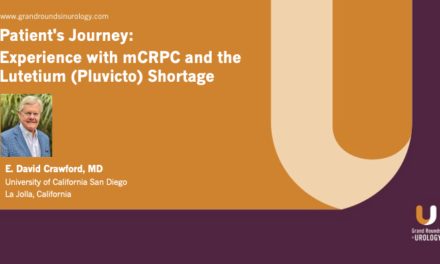
PCa Commentary | Volume 172 – December 2022
Posted by Edward Weber | December 2022
METASTASES DIRECTED THERAPY (MDT):
Can Concomitant Hormone Suppression Be Avoided?
Metastases Directed Therapy (MDT) refers to targeted radiation, such as CyberKnife, directed at a few (usually 3-5) osseous or nodal metastatic lesions for the purpose of controlling all imageable disease, delaying cancer progression, and, if not accompanied by ADT, delaying the development of castration-resistance. Radiation therapy has resulted in near-total suppression of targeted lesions in ~95%. Many studies of MDT in the oligometastatic setting have consistently shown that MDT, as compared to no therapy, delays PSA progression and the emergence of additional metastases. An important question, currently without answer, is whether MDT should be accompanied by ADT, considering that MDT alone has consistently been found to delay PSA progression and extend metastasis-free survival. The issue involved herein is a trade-off: Concurrent ADT provides additional clinical benefit, but at the cost of adverse toxicity and the acceleration of castration resistance development.
This issue is clinically relevant because oligometastatic prostate cancer is increasingly prevalent largely due to the more frequent use of PSMA PET scans (such as Pylarify) at initial diagnosis in men with high-risk disease or at PSA recurrence after primary therapy. As a consequence, MDT has become a more frequent management opportunity. Before the increasing acceptance of MDT, men with de novo metastatic hormone sensitive prostate cancer (mHSPC) or metastatic recurrence were treated with androgen suppression alone—and for many men this regimen remains applicable.
The Search for Optimal Candidates for MDT: Patient Selection
Current studies are searching for features (clinical and molecular) to identify men who can be predicted to have a favorable ADT-free outcome from MDT without ADT, thus avoiding the unwelcome adverse effects of androgen deprivation. The search is for markers of disease aggressiveness. The early trials of MDT mainly involved men whose selection was based only on the number of lesions diagnosed on conventional imaging, without PSMA PET imaging, and without consideration of underlying biologic features. Although the number of lesions treated in MDT studies varies, the predominant median number in many trials is one or two.
Deek et al., (J Clin Oncol, 2022) analyzed two major trials of MDT in mHSPC in which no ADT was employed. Their search was for genetic predictors of outcome from MDT. They reported that mutated BRCA 1, 2, ATM, Rb1 and TP53 were strongly associated with poorer outcome. Median PSA progression-free survival (PFS) was ~12 months in those men without a high-risk mutation compared to ~6 months for those with one or more. Median freedom from radiographic progression was 22.6 months versus 10 months, respectively. “The group without adverse mutations had a better outcome, but PFS beyond four years was 15%-20% with MDT regardless of mutation status, and thus, a sizable proportion of patients will experience durable response to therapy.” (Deek, ibid.)
Wang et al., (Prostate Cancer and Prostatic Diseases. 2022) advanced this search by genetically profiling men with mHSPC and CRPC (castration-resistant prostate cancer) to identify mutations associated with CRPC progression. Targeted sequencing of tumor tissue and circulating free DNA provided data to establish a panel of four genetic mutations (MSH2, CDK12, TP53 and RB1) “capable of predicting which mHSPC patient has a high risk of early CRPC progression” and were less suitable for MDT. This panel could guide the selection of men for MDT.
Of note: Inactivating mutations in CDK12, found in 7% of advanced cancers, create abundant neoantigens. A proportion of men with CDK12 deficiency respond to immunotherapy with checkpoint inhibitors.
ADT or No ADT with MDT— That is the Question:
There is abundant and consistent evidence that using ADT with MDT delays disease progression. There is also clear evidence based on work by Dr. Dan Spratt (Spratt et al. Clin Res. 2016) that ADT potentiates the effectiveness of radiotherapy. However, to the contrary is awareness that when the androgen receptor is inhibited by diminished testosterone, mutations and adaptations in the androgen receptor are evoked that promote hormone resistance and accelerate the development of CRPC. It is the awareness of these two opposing effects that underlines the search for predictive biomarkers of the risk of early progression and their application to inform in which men MDT alone could extend freedom from progression for a sufficient duration to justify withholding ADT.
An article by Andrews et al., UROLOGY, 2020, “Metastases-directed Therapy Without Androgen Deprivation Therapy in Solitary Oligorecurrent Prostate Cancer” found ADT-free survival was prolonged to a median of ~18.5 months with MDT alone. The instructive aspect in their data was that the numerical range for the calculation of the median ADT-free survival was wide, ~7 to 44 months, illustrating that ADT-free survival could be potentially satisfyingly long for some men without ADT—presumably those with very favorable clinical and molecular characteristics.
Two New Regimens Combining MDT but with only 6 Months of Hormone Therapy.
When ADT is used with MDT it is usually continued until subsequent progression. The schema of two new protocols shorten the duration of ADT to minimize adverse effects. The NCT trial (DART 04641078) is evaluating MDT with SBRT (stereotactic body radiotherapy) but using Darolutamide for only 6 months. A second regimen (EXTEND, NCT 03599765) reported by Tang et al, found improved PFS from MDT when combined with only 6 months of hormone therapy compared to 6 months of hormone therapy only.
A Model of Outcome for MDT Without ADT: “Extended Results and Independent Validation of a Phase 2 Trial of Metastasis-Directed Therapy for a Molecularly Defined Oligometastatic Prostate Cancer” Glicksman et al., Rad Oncol Bio Phys, 2022.
This trial evaluated 74 men with intermediate- and high-risk cancer who sustained biochemical failure ( PSA 0.4-3.0 ng/ml) after primary therapy with surgery or radiation. All were negative on conventional imaging, but were found to harbor metastases on a Pylarify PET CT. No patient received ADT. The recurrent metastases were found in 87% in regional pelvic nodes and 13% in bone. The median number of lesions treated with SBRT per patient was 2. The PSA response (defined as >50% lower than baseline) to MDT was 51.4%, with a complete response in 20.3%. No response to MDT was seen in 25% of men.
Their Findings: The median time to biochemical progression was 21 months. The median time to the initiation of ADT was 44.8 months. Ten men underwent a second course of MDT with a median time to PSA progression of 19.8 additional months. They emphasized the need to “pursue biomarker research to better identify subgroups of patients, beyond conventional prognostic indices, who will (or will not) benefit from MDT.”
BOTTOM LINE:
Metastasis Directed Therapy in men with three to five lesions delays PSA and metastatic progression. Current research is directed toward identifying men who can be predicted to have satisfyingly long ADT-free survival without concurrent ADT.
Your comments and requests for information on a specific topic are welcome e-mail ecweber@nwlink.com.
Please also visit https://prostatecancerfree.org/prostate-cancer-news for a selection of past issues of the PCa Commentary covering a variety of topics.
“I want to thank Dawn Scott, Staffperson, Tumor Institute Radiation Oncology Group, and Mike Scully, Librarian, Swedish Medical Center, for their unfailing, timely, and resourceful support of the Commentary project. Without their help this Commentary would not be possible.”
ABOUT THE AUTHOR
Edward Weber, MD, is a retired medical oncologist living in Seattle, Washington. He was born and raised in a suburb of Reading, Pennsylvania. After graduating from Princeton University in 1956 with a BA in History, Dr. Weber attended medical school at the University of Pennsylvania. His internship training took place at the University of Vermont in Burlington.
A tour of service as a Naval Flight Surgeon positioned him on Whidbey Island, Washington, and this introduction to the Pacific Northwest ultimately proved irresistible. Following naval service, he received postgraduate training in internal medicine in Philadelphia at the Pennsylvania Hospital and then pursued a fellowship in hematology and oncology at the University of Washington.
His career in medical oncology was at the Tumor Institute of the Swedish Hospital in Seattle where his practice focused largely on the treatment of patients experiencing lung, breast, colon, and genitourinary cancer and malignant lymphoma.
Toward the end of his career, he developed a particular concentration on the treatment of prostate cancer. Since retirement in 2002, he has authored the PCa Commentary, published by the Prostate Cancer Treatment Research Foundation, an analysis of new developments in the prostate cancer field with essays discussing and evaluating treatment management options in this disease. He is a regular speaker at various prostate cancer support groups around Seattle.




